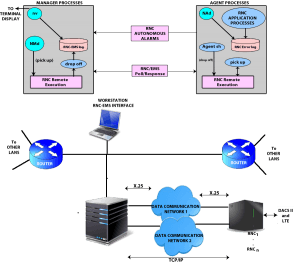As an Amazon Associate, I earn from qualifying purchases.
What Does Adaptive Tuning Protocol Stand For?
ATP, also known as “Adaptive Tuning Protocol”, is a data transport layer protocol in Internet network design. This Internet protocol helps conserve energy performance, especially within the Internet of Things (IoT). During transfer of Internet packets, there is a significant consumption of energy, especially on the battery power of network infrastructure sensor node and this issue can constitute a problem if not checked.
 The overhead problem is normally caused by the regular update messages that are sent to the Internet service directories.
The overhead problem is normally caused by the regular update messages that are sent to the Internet service directories.
ATP, therefore, is the protocol used as an adaptive tuning resolution in between the sensor nodes and the resource directory, in order to adjust the number and frequencies of updates by checking the battery performance levels of the sensing node. This protocol can work in different modes for effectiveness.
Nowadays, it is believed that more than 3 billion devices rely on the Internet for data usage and by the end of the decade, it is expected that there will be over 50 billion devices on the planet. For this reason, the ATP will play a pivotal role, especially in ensuring that Internet services will be reached by all devices. Unless there is a mechanism put in place, the massive number of sensors that will be required to handle the growing demands for Internet services will be too much to handle.
The importance of the ATP within the Internet network transport layer
The ATP protocol within the transport layer of network infrastructure may provide numerous services, including the following:
- Provide a connection-oriented communication, whereby it interprets connection as a data stream rather than dealing with the underlying connection models. This will allow the ATP to focus on classifying data in order to reduce overload.
 Provide same order delivery, in which it allows data to arrive the same way they are sent. The network layer cannot guarantee that data will arrive the same way they are sent. This is definitely a desirable service within the network architecture especially when segment numbering is involved.
Provide same order delivery, in which it allows data to arrive the same way they are sent. The network layer cannot guarantee that data will arrive the same way they are sent. This is definitely a desirable service within the network architecture especially when segment numbering is involved.- It offers a reliable system of network handling. It is believed that some packets of data may be lost while being transmitted from one end to the other. Loss of data packets may result from congestion in Internet network, and numerous errors. The ATP makes use of different error detection codes to ensure that data being transferred is not corrupted and thereafter will verify the receipt of data being sent by sending a message to the data packet sender. Lost and corrupted data can be re-transmitted via the ATP protocol, through the use of “Automatic repeat request”.
- It provides an excellent flow control service within the network infrastructure. It provides this service by managing the rate of data transmission, in-between two nodes.
- It ensures flow control by ensuring that the rate of data transfer between two nodes are managed effectively to ensure that fast message senders are prevented from transmitting too many messages more than what can be supported by the network. It does this by creating a “Data buffer,” which is intended to trigger a data overrun. This step can also be used in preventing data under-run and boost efficiency.
 It helps prevent or avoid congestion. Within the transport layer of the network infrastructure, the ATP can help prevent or avoid data congestion by providing a traffic control entry into Telecommunication networks. This, in turn, will help prevent congestive collapse through the avoidance of the over-subscription to the processing of data between nodes. It can also handle this situation by reducing the rates at which data packets are sent.
It helps prevent or avoid congestion. Within the transport layer of the network infrastructure, the ATP can help prevent or avoid data congestion by providing a traffic control entry into Telecommunication networks. This, in turn, will help prevent congestive collapse through the avoidance of the over-subscription to the processing of data between nodes. It can also handle this situation by reducing the rates at which data packets are sent.- For instance, a network may be kept in a redundant or congested state when there are too many automatic requests. This situation can be prevented by simply adding congestion avoidance to the flow of control. An example of congestion avoidance is “slow start” technique that will simply keep the bandwidth consumption at a very low level, especially at the beginning of transmission or after the transmission of the packets.
- Multiplexing functions. These are specific functions in which different ports are provided with multiple entry points within singles. This simply means different recipients forwarding data to the same location can be distinguished from each other through the use of different entry points on the same port. This also means you can make use of more than one network at the same time.
The ATP is an essential component of network infrastructure transport layer that delivers data to the appropriate process within different host computers. The multiplexing of data from different processes of application will help in reducing redundancies in the formation of data packets, while the addition of source and destination port numbers in the header of the transport layers will ensure that communication is facilitated within the network infrastructure.
 Though the ATP is not directly involved in some other processes such as the generation of error recovery codes, but it plays a prominent role in such functions by generating the repeat request protocols, which is necessary for the identification of the source of an error and possible solutions to such errors.
Though the ATP is not directly involved in some other processes such as the generation of error recovery codes, but it plays a prominent role in such functions by generating the repeat request protocols, which is necessary for the identification of the source of an error and possible solutions to such errors.
ATP is able to handle different errors because of the different codes attached to such errors; therefore, it takes little or no time to resolve errors by identifying such codes. This ensures that vulnerabilities and latency risks are reduced.
The ATP protocol of Internet network can be configured according to the size of the Local Area Network (LAN) or Wide Local Area Network (WLAN). This means that the protocol is needed for smaller and wider networks. The reliability of ATP makes it easier for network administrators to implement several other protocols into a network. For instance, securing a network infrastructure becomes much easier when an effective ATP is deployed. With an effective ATP structure, networks would be less susceptible to phishing and some other vulnerable attacks.
Amazon and the Amazon logo are trademarks of Amazon.com, Inc, or its affiliates.
